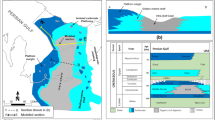Abstract
To estimate the undiscovered hydrocarbon potential of sedimentary basins, quantitative play assessments specific for each location in a region may be obtained using geostatistical methods combined with the theory of classification of geological objects, a methodology referred to as regionalization. The technique relies on process modeling and measured borehole data as well as probabilistic methods to exploit the relationship between geology (the “predictor”) and known hydrocarbon productivity (the “target”) to define prospective stratigraphic intervals within a basin. It is demonstrated in case studies from the oil-producing region of the western Kansas Pennsylvanian Shelf and the gas-bearing Rotliegend sediments of the Northeast German Basin.
Similar content being viewed by others
References
Allen, P. A., and Allen, J. R., 1990,Basin Analysis—Principles and Applications: Blackwell Sci. Pub., Oxford, 451 p.
Gnedenko, B. W., 1970,Lehrbuch der Wahrscheinlichkeitsrechnung: Akademie Verlag, Berlin, 399 p.
Harff, J., and Davis, J. C., 1990, Regionalization in Geology by Multivariate Classification: Math. Geol., v. 22, n. 5, p. 573–588.
Harff, J., Eiserbeck, W., Hoth, K., and Springer, J., 1990, Modellierung Tiefer Sedimentärer Becken zur Perspektivitätsbewertung von Erdöl und Erdgas: Veröff. Niedersächs. Akademie Geowiss., v. 4, p. 91–95.
Harff, J., Davis, J. C., and Olea, R. A., 1991, Quantitative Assessment of Mineral Resources with an Application to Petroleum Geology: Nonrenewable Res. v. 1, n. 1, p. 74–84.
Harff, J., Davis, J. C., Olea, R. A., and Bohling, G., 1991, Regionalization of Western Kansas Based on Multivariate Classification of Stratigraphic Data from Oil Wells, II: Kansas Geol. Survey, Open-File Report 91–40, 30 p.
Harff, J., Olea, R. A., and Bohling, G., in press. From Multivariate Sampling to Thematic Maps with an application to Marine Geochemistry,in J. C. Davis and U. C. Herzfeld (eds.),Computers in Geology: 25 Years of Progress: Oxford Univ. Press, New York.
Journel, A. G., and Huijbregts, C. J., 1978,Mining Geostatistics: Academic Press, New York, 600 p.
Rodionov, D. A., 1981,Statisticěskie Resěnija v Geologii.: Izd. “Nedra,” Moskva, 231 p.
Tissot, B. P., and Welte, D. H., 1984,Petroleum Formation and Occurrence Springer Verlag, Berlin, 699 p.
Watney, W. L., 1984, Recognition of Favorable Reservoir Trends in Upper Pennsylvanian Cyclic Carbonates in Western Kansas,in N. J. Hyne (ed.),Limestones of the Mid-Continent: Tulsa Geol. Soc. Spec. Publ. No. 2, p. 201–246.
Author information
Authors and Affiliations
Rights and permissions
About this article
Cite this article
Harff, J.E., Davis, J.C. & Eiserbeck, W. Prediction of hydrocarbons in sedimentary basins. Math Geol 25, 925–936 (1993). https://doi.org/10.1007/BF00891051
Received:
Accepted:
Issue Date:
DOI: https://doi.org/10.1007/BF00891051




